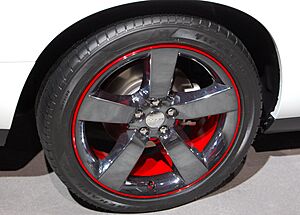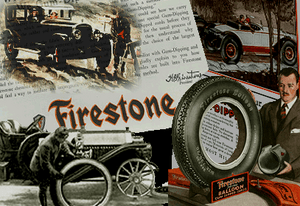Firestone Tire and Rubber Company facts for kids
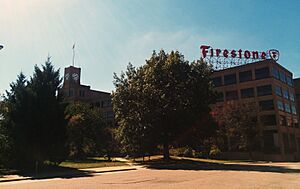
Former Firestone Tire and Rubber Company headquarters in Akron, Ohio.
|
|
| Subsidiary | |
| Industry | Manufacturing |
| Founded | August 3, 1900 Akron, Ohio, U.S. |
| Founder | Harvey S. Firestone |
| Headquarters |
Akron, Ohio (1900–1987; 1989–1992)
Chicago, Illinois (1987–1989) Nashville, Tennessee (1992–Present) |
|
Number of locations
|
1,700 repair shop locations |
|
Area served
|
Worldwide |
|
Key people
|
|
| Products | Tires |
| Revenue | |
|
Number of employees
|
33,000 |
| Parent | Bridgestone |
Firestone Tire and Rubber Company is an American tire company. It was started by Harvey S. Firestone in 1900. At first, Firestone made strong rubber tires for fire trucks. Soon, they also made air-filled tires for wagons, carriages, and early cars.
Harvey S. Firestone quickly saw how important tires would be for automobiles. His company became a leader in making many tires at once. He was friends with Henry Ford, who founded Ford Motor Company. This friendship helped Firestone become the main tire supplier for Ford cars. Firestone also sold tires to people who needed to replace their old ones. In 1988, a Japanese company called Bridgestone Corporation bought Firestone.
Contents
The Story of Firestone
Early Years and Growth
Firestone began in Akron, Ohio, which was also home to its main rival, Goodyear Tire and Rubber Company. The company started on August 3, 1900, with just 12 employees. For over 75 years, Firestone and Goodyear were the biggest tire suppliers in North America. In 1906, Henry Ford chose Firestone to provide tires for his Ford cars.
In 1918, Firestone Tire and Rubber Company of Canada was created in Hamilton, Ontario. The first Canadian-made tire was produced there on September 15, 1922. During the 1920s, Firestone made a tire called the Oldfield, named after famous racing driver Barney Oldfield.
In 1926, Firestone opened one of the world's largest rubber plantations in Liberia, West Africa. It covered over 1 million acres. That same year, the company also opened its first Firestone Tire and Service Center. These centers, now called Firestone Complete Auto Care, offer car maintenance and repair, including tires.
In 1927, Harvey S. Firestone visited Southern California to find places for new factories. He chose a spot in South Gate, California, which was mostly farmland then. Firestone built a large, beautiful factory there. The town grew around the factory, and its main road was named Firestone Boulevard after Harvey. Los Angeles became a huge market for tires. The South Gate plant closed in 1980, and 1,300 workers lost their jobs.
In 1928, Firestone built a factory in Brentford, England. This factory was known for its Art Deco style. It closed in 1979 and was later taken down.
A plant opened in Memphis, Tennessee, in 1936. It was the largest tire factory for Firestone worldwide, with over 3,000 employees. By 1963, this plant had made 100 million tires. The Memphis plant closed in 1982.
During World War II, the U.S. Government asked Firestone to make things for the war effort. They produced artillery shells, aluminum containers for food, and rubber military products. They also made barrage balloons in Akron. Firestone was one of the top U.S. companies helping with wartime production. They also made plastic helmet liners for the M1 Helmet.
In 1941, a large fire at a Firestone plant in Fall River, Massachusetts, destroyed many buildings and 15,000 tons of rubber. The fire caused $12 million in damage.
In 1951, Firestone received a contract to build the MGM-5 Corporal missile. This was a surface-to-surface guided missile. It could carry a powerful warhead up to 75 nautical miles. Later, it was changed to carry a nuclear payload during the Cold War. This missile was built in southern California.
Firestone bought the Dayton Tire division in 1961 and the Seiberling Rubber Company in 1965.
Changes and Sale to Bridgestone
In the late 1970s, Firestone was facing big financial problems. John Nevin became president to help save the company. He closed many factories and moved the company's main office from Akron, Ohio, to Chicago, Illinois. He also sold off parts of the business that weren't about tires, like the Firestone Country Club. These changes helped the company's value grow.
In 1988, Nevin arranged for the Japanese company Bridgestone to buy Firestone. Bridgestone was able to buy the company for much less than it had been worth before. In 2008, the companies celebrated 20 years together and changed the tire division's name to Bridgestone Americas Tire Operations, LLC.
Bridgestone Americas, which is the American part of Japan-based Bridgestone, moved its main office to downtown Nashville in 2017.
In 2012, Bridgestone Americas opened its new Bridgestone Americas Technical Center in Akron, Ohio. This $100 million facility develops new tire technologies. In 2022, Bridgestone opened a new Advanced Tire Production Center in Akron. This new building makes racing tires for the NTT IndyCar Series. It is the first new tire plant in Akron in over 70 years. Bridgestone also opened a test track nearby to help develop passenger tires.
Firestone Complete Auto Care
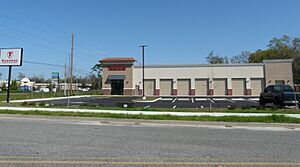
Firestone Complete Auto Care is a group of car maintenance shops. They started in Nashville, Tennessee, in 1926.
There are over 2,300 Firestone Complete Auto Care locations across the United States. All of them are owned by Firestone. As of 2002, they served about 20 million customers each year. In 2022, Bridgestone announced that it would expand its services for hybrid and electric vehicles.
Firestone in Motorsports
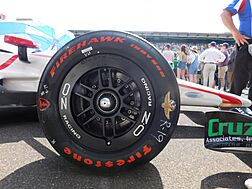
Cars using Firestone tires won the Indianapolis 500 auto race in 1911. They also won every Indy 500 race from 1920 to 1966. The company also supplied tires for NASCAR from 1948 to 1974 and for Formula One from 1950 to 1974.
In 1974, Firestone announced it would stop being involved in most professional motorsports because of rising costs. However, they returned in 1995 to the CART Series. Firestone has been the only tire supplier for the IndyCar Series since 2000 and will continue until the 2030 season.
Challenges Faced by Firestone
Tire Safety Concerns
In the 1970s, Firestone faced big problems with its Firestone 500 radial tires. These tires sometimes had their tread separate, especially at high speeds. It was believed that the way the tread was attached to the tire might have allowed water inside, causing the steel wires to rust.
In 1978, the U.S. National Highway Traffic Safety Administration (NHTSA) started an investigation into the Firestone 500 tires. They found that the tread separation was likely a design problem. An internal memo from 1973 showed that a Firestone director had warned about making an "inferior quality radial tire."
Firestone tried to improve quality control, but the basic problems remained. In 1977, 400,000 tires from a specific plant were recalled. Firestone initially blamed customers for not keeping their tires properly inflated.
On October 20, 1978, Firestone recalled over 7 million Firestone 500 tires. This was the largest tire recall at the time. Government hearings also took place. The tire was found to be faulty and linked to accidents. In 1980, the NHTSA fined Firestone $500,000 because they knew the tires were defective. This was the largest fine ever given to a U.S. company at that time. Many lawsuits were settled, and the negative news hurt the company's sales and reputation.
Business schools like Harvard Business School studied Firestone's management decisions during this time. After years of bad publicity and paying out millions to victims, Firestone was losing a lot of money, and its name was badly damaged.
Rubber Plantation in Liberia
Firestone started its Natural Rubber plantation in Harbel, Liberia, in 1926. For many years, it was the largest plantation of its kind in the world. The company faced challenges in Liberia, especially during times of conflict.
In 1990, during the First Liberian Civil War, Firestone had to remove its American workers. The company tried to restart operations in 1991 and 1992, but had to stop again when fighting increased. Operations fully restarted in 2003 after the Second Liberian Civil War ended. Since then, Firestone has invested over $100 million to rebuild its facilities in Liberia.
The company's work in Liberia has been looked at closely by various groups. There have been discussions about labor practices and the challenges of operating in a country affected by war.
Ford Explorer Tire Issues
In 1996, some government agencies in Arizona reported problems with Firestone tires on Ford Explorer vehicles. News reports said that these agencies asked for new tires. Firestone investigated and tested the tires, suggesting they might have been misused or under-inflated.
In 2000, a consumer safety group called Public Citizen spoke to the U.S. Senate. They pointed out similarities between this situation and the 1978 Firestone 500 recall. They also mentioned that Ford Motor Company had asked Firestone to add a nylon layer to tires made in Venezuela for extra strength, and that Ford had changed the Explorer's suspension in Venezuela. These changes were not made for U.S.-made Firestone tires or U.S. Explorer models at that time.
A high number of failures in Firestone's Wilderness AT, Firestone ATX, and ATX II tires led to lawsuits and a required recall. In 2001, Bridgestone/Firestone ended its relationship with Ford, saying they no longer trusted each other. This lack of trust came from concerns that Ford had not listened to Firestone's warnings about the design of the Ford Explorer. In 2006, Firestone announced new efforts to recall tires of the same model recalled in 2000, as they were linked to more accidents.
Some people have debated who was more responsible. Firestone tires were prone to tread separation, and the SUVs were more likely to roll over if a tire failed at speed compared to other vehicles. A later investigation by NHTSA found that Ford Explorer SUVs were not more likely to roll over after a tread separation than other SUVs.
Researchers have also suggested that a labor dispute at Firestone's Decatur plant from 1994 to 1996 might have contributed to the higher defect rates of tires made during that time.
Famous Jingle
Where the Rubber Meets the Road is a well-known advertisement jingle for Firestone. It was often heard in the 1960s and 1970s, especially during televised sports events. The jingle was sung by Don Rondo.
- Wherever wheels are turning,
- No matter what the load,
- The name that's known is Firestone
- Where the rubber meets the road.
Other Tire Brands
Bridgestone/Firestone also makes tires under the Fuzion brand name. Fuzion tires are made in China as a more affordable replacement option. These include the Fuzion UHP Sport A/S, SUV, and Touring models.
Company Leaders
Presidents of Firestone
- Harvey S. Firestone, 1903–1935
- John W. Thomas, 1935–1943
- Harvey S. Firestone Jr., 1943–1949
- Lee R. Jackson, 1949–1957
- Raymond C. Firestone, 1957–1965
- Earl B. Hathaway, 1965–1971
- Robert D. Thomas, 1971–1972
- Richard A. Riley, 1972–1976
- Mario A. DiFederico, 1976–1979
- John J. Nevin, 1979–1982
- Leon R. Brodeur, 1982–1984
- John J. Nevin, 1984
Chairmen of the Board
- Harvey S. Firestone, 1932–1939
- John W. Thomas, 1943–1949
- Harvey S. Firestone Jr., 1949–1966
- Raymond C. Firestone, 1966–1976
- Richard A Riley, 1976–1981
- John J. Nevin, 1981–
See also
 In Spanish: Firestone para niños
In Spanish: Firestone para niños
- Harvey S. Firestone
- Firestone-Apsley Rubber Company
- Bridgestone
- Formula One tires
- NTT IndyCar Series




